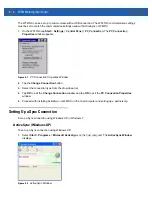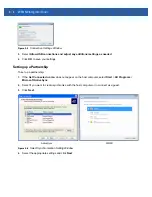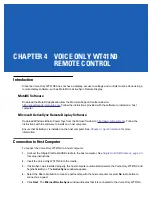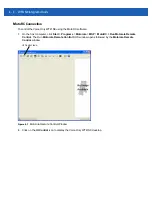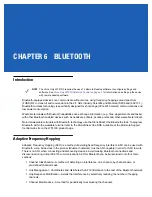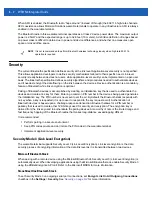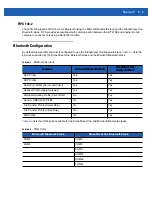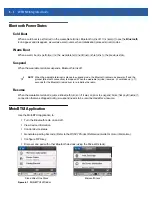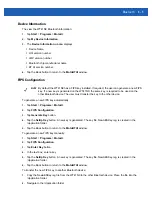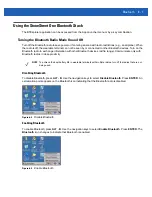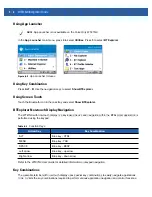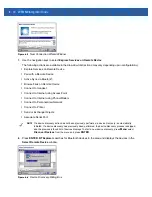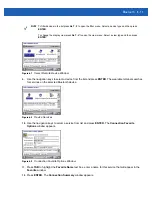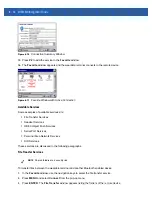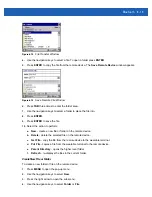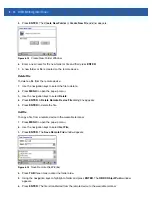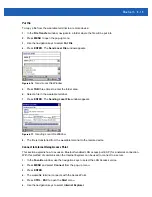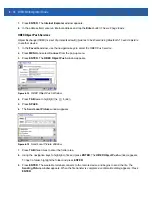
6 - 2
WT41N0 Integrator Guide
When AFH is enabled, the Bluetooth radio “hops-around” (instead of through) the 802.11b high-rate channels.
AFH coexistence allows Motorola Solutions wearable terminals to operate in any infrastructure. AFH is always
enabled in the wearable terminal.
The Bluetooth radio in this wearable terminal operates as a Class 2 device power class. The maximum output
power is 2.5mW and the expected range is up to 32.8 feet (10 meters). A definitive definition of ranges based
on power class is difficult to obtain due to power and device differences, and whether one measures open
space or closed office space.
Security
The current Bluetooth specification defines security at the link level. Application-level security is not specified.
This allows application developers to define security mechanisms tailored to their specific need. Link-level
security is really between devices not users, while application-level security can be implemented on a per-user
basis. The Bluetooth specification defines security algorithms and procedures needed to authenticate devices,
and if needed, encrypt the data flowing on the link between the devices. Device authentication is a mandatory
feature of Bluetooth while link encryption is optional.
Pairing of Bluetooth devices is accomplished by creating an initialization key that is used to authenticate the
devices and create a link key for them. Entering a common PIN number in the devices being paired generates
the initialization key. The PIN number is never sent over the air. By default, the Bluetooth stack responds with
no key when a key is requested (it is up to user to respond to the key request event). Authentication of
Bluetooth devices is based-upon a challenge-response transaction. Bluetooth allows for a PIN number or
passkey that is used to create other 128-bit keys used for security and encryption. The encryption key is
derived from the link key used to authenticate the pairing devices. Also worthy of note is the limited range and
fast frequency hopping of the Bluetooth radios that makes long-distance eavesdropping difficult.
It is recommended:
•
Perform pairing in a secure environment
•
Keep PIN codes private and don't store the PIN codes in the wearable terminal
•
Implement application-level security.
Security Mode 3 (Link Level Encryption)
The wearable terminal supports Security Level 3 (Link Level Encryption). Link level encryption is the data
security process of encrypting information at the data link level as it is transmitted between two devices.
Microsoft Bluetooth Stack
When pairing with a remote device using the Microsoft Bluetooth UI, Security Level 3 (Link Level Encryption) is
automatically used. When developing applications using the Microsoft Bluetooth stack, enable Security Mode 3
using the
BthSetEncryption
API call. Refer to the Microsoft MSDN for more information.
StoneStreet One Bluetooth Stack
To set Security Mode 3 on outgoing serial port connections, set
Encrypt Link On All Outgoing Connections
checkbox in the
Settings
>
Security
. See
for more information.
NOTE
It is not recommended to perform Bluetooth wireless technology inquiry when high rate 802.11b
operation is required.
Summary of Contents for WT41N0
Page 1: ...WT41N0 WEARABLE TERMINAL INTEGRATOR GUIDE ...
Page 2: ......
Page 3: ...WT41N0 INTERGRATOR GUIDE 72E 160600 01 Rev A December 2012 ...
Page 6: ...iv WT41N0 Integrator Guide ...
Page 18: ...xvi WT41N0 Integrator Guide ...
Page 60: ...3 6 WT41N0 Integrator Guide ...
Page 64: ...4 4 WT41N0 Integrator Guide ...
Page 118: ...7 16 WT41N0 Integrator Guide ...
Page 122: ...8 4 WT41N0 Integrator Guide ...
Page 154: ...A 20 WT41N0 Integrator Guide ...
Page 156: ...B 2 WT41N0 User Guide ...
Page 170: ...Index 4 WT41N0 Integrator Guide ...
Page 171: ......

